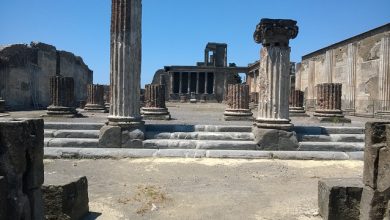The 15 countries that are most vulnerable to earthquakes

Every year, 20,000 people around the world suffer from earthquakes. The chance that you will ever fall victim to it is not the same in every country. That depends not only on how often and how violently it shakes, but also on how well a country is prepared for it. The Global Earthquake Model Foundation (GEM) has mapped out all the factors and has now drawn up a list of 15 countries where earthquakes cause the most damage and kill people.
The scientists have identified which parts of the world are most dangerous in terms of frequency and impact of earthquakes. They took different factors into account. First, they looked at the frequency: how likely is it that it trembles in a certain area.
In addition, one also had to measure the human element: how vulnerable is a population for an earthquake. In doing so, they took account of, among other things, the fragility of the infrastructure, the population, the density of the population, the number of victims of past earthquakes and weather conditions, and geographical factors that could make rescue operations more difficult.
After years of research, the GEM could conclude that there were fifteen countries where the risk is greatest. Most countries on the list are in Asia or South America.
1) China
In the first place is the country with the most inhabitants in the world. Half of the fatalities of earthquakes are Chinese. That has been the case for the past fifty years, that has been the case for the past 500 years, says John Schneider, Secretary General of the GEM. One of the worst earthquakes in recent history occurred in 1976 in Tangshan. At the quake of 7.6 on the Richter scale, 242,769 were killed.
The economic damage that China suffers annually is also considerable. On this map you can zoom in to see which areas on average suffer the most financial loss as a result of earthquakes.
2) Japan
Japan is known as the country with the most seismic activity in the world. The country is located in the so-called Ring of Fire, the horseshoe-shaped area around the Pacific Ocean where earthquakes and volcanic eruptions are winding through various subduction zones of tectonic plates. A subduction zone is a zone where an oceanic surface moves under a continental or other oceanic surface.
In 2007, a system was introduced that should detect early vibrations with 1,000 seismometers around the island. This system generates automatic warnings that appear on mobile phones, radio and TV, giving people a few seconds extra time to get to safety. Often, however, that is not enough.
Last September at least 39 people were killed on the northern island of Hokkaido after a quake of 6.7. That was small beer compared to the earthquake of 7.9, which hit the capital Tokyo in 1923 and made 142,807 fatalities.
3) Iran
In Iran the Eurasian and Arabic plates collide. As a result, it often vibrates in the Islamic Republic. In 2017, 400 people were killed in an earthquake of 7.3. Mud flows then made the rescue operations difficult.
The riskiest region is the region in and around the capital Tehran, which lies at the foot of the country’s highest mountain, the Damavand.
4) Philippines
The country in Southeast Asia is just like Japan in the Ring of Fire. In 2013 more than 130 people died in an earthquake of 7.2. In 1976 an estimated 3,000 people died. 40,000 people lost their home. The earthquake then had a force of 7.9.
5) Indonesia
The same story applies to Indonesia as to the Philippines. Due to the geographic location, the country is susceptible to heavy earthquakes. The infrastructure also makes the country extra vulnerable.
2018 was a particularly tough year for Indonesia. More than a hundred people were killed when the tourist island of Lombok was hit by an earthquake in August. A quake with a force of 7.5 hit Sulawesi in September, followed by a tsunami and another 170 aftershocks. The death toll was finally set at 2000, but it is feared that it actually involves 5000 victims.
6) Turkey
Earthquakes are the most important natural threat to the country. Capital Istanbul is also on an active fault line. The head of Istanbul’s earthquake centre warns that the city and its 14 million inhabitants will have an earthquake in the near future.
“All scientists agree that an earthquake is on the rise with a magnitude of 7 or more in the Marmara region but we can not put a date on it”, said Haluk Ozener expert at a press conference in 2017. “The only thing we can do is limit the damage “, it sounded.
However, many buildings in the region run the risk of collapsing in the event of such a quake. In 1999, a quake destroyed 113,000 buildings in the region. There were also 18,000 deaths.
The association of architects in Istanbul estimates that two million buildings are currently unsafe.
7) India
In the second most populous country in the world, the risk of fatalities in the event of a quake is high. Especially the region around Delhi is dangerous, because the city lies on the edge of the Indian tectonic plate. Their architecture also increases the risk of damage: there are many brick buildings that can easily collapse and crush people.
In Delhi alone, the annual costs of earthquakes amount to 150 million dollars.
8) Mexico
After seven Asian countries, Mexico is the first Central American country in the list of most dangerous countries. The country lies on the fault line between the three largest plates in the world: the North American, the Cocos plate and the Pacific plate.
The sensitivity of the capital Mexico City to earthquake also has to do with the underground on which the city was built. When the Spaniards conquered the current Mexico City in 1519, they found a kind of Venice. As the city grew, the channels were closed. But the bottom has remained soggy and therefore unstable.
In 1985 and 2017, two major earthquakes occurred in the metropolis of Mexico City, with many victims and damage. In 1985, according to some estimates, there were 40,000 fatalities in a quake of 8.1. Other figures speak of 10,000 deaths. In 2017 there were more than 200 and forty buildings also collapsed.
9) Nepal
Like the other countries, Nepal is on a fault line between plates. More than 25 million years ago, India was an isolated island. This island lay on the Indian plate that quickly moved towards the mainland of Asia. Ten years ago, both records clashed. Because of the forces that were released during this collision, many earthquakes arose with the result that the Himalayas arose.
Earthquakes, small and large, are part of the history of Nepal with sometimes very serious consequences. Recently, however, Nepal started to start building differently to limit the damage. Whether a building collapses during a quake depends to a large extent on the material. For example, steel and wood are much more earthquake resistant than brick or adobe.
Schneider of the GEM notes that existing buildings should not be demolished: “One can also build safely with adobe and brick” and gives as an example a kind of steel mesh around existing constructions.
10) Pakistan
Pakistan is also a risky area. In 2005, a severe quake killed 76,000 people.
Pakistan is on the fault line between the Indian and Eurasian plate. The risk of earthquakes is greatest in the villages in the mountainous north.
11) Bangladesh
Bangladesh is one of the most densely populated countries in the world. In a recent study, researchers warn that a very heavy earthquake is on the way that would hit at least 140 million Bangladeshis.
12) Ecuador
Ecuador is vulnerable to earthquakes, because the Nazca plate is diving under the South American continent. This subduction, incidentally, caused the heaviest earthquake of the 20th century: a magnitude 9.5 magnitude quake in Chile in the year 1960.
In 1987, about 5,000 people died in an earthquake of magnitude 7.7 in Quito, the capital of Ecuador. In 1949 6,000 people were killed in an earthquake in Ambato in central Ecuador.
13) Guatemala
We stay in South America with Guatemala. In 1976 there were no less than 23,000 fatalities at an earthquake of 7.5 in Chimaltenango, less than 70 kilometres west of the capital Guatemala City. In 2012, there were 48 deaths.
14) United States
112 years ago, San Francisco was razed to the ground in the USA. Approximately 3,000 people were killed. Countless people lost their homes.
The city on the east coast lies on the fault line of San Andreas and is therefore sensitive to earthquakes.
According to a recent survey, there is a 76 percent chance that the region will be hit by an earthquake of more than 7 in the next 30 years.
15) Peru
Peru closes the list of 15 most dangerous countries for the same reason as Ecuador: Peru is where the Nazca plate dives under the continent. In 1970 there were 60,000 deaths. The most dangerous region is the region around the capital Lima.




